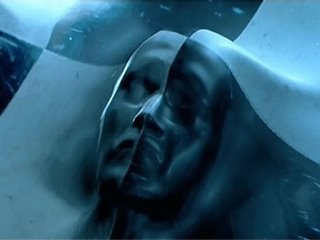Last year, writer Jason Jack Miller shared with me a popular YouTube video of uncanny monsters born by placing a layer of water and cornstarch on a subwoofer. I find myself returning to these videos often, contemplating the animism made possible by the rhythm of sound and the chaos of vibration. This neat effect “animates” the preternatural spatzle dough (a.k.a. “Oobleck”) in a way that makes it seem like the liquid gives birth to monstrous blobs that have a will to dance all their own. It gets progressively creepier until the “mass” writhes with uncanny life.
One of the reasons this neat trickery appeals to me is because it is also so familiar from fiction and film. This is but one of many examples of something we might call the “Oobleck Effect” in uncanny narratives: a representation of “living fluid” in the works of popular culture (especially film). Liquid, by its very nature, often seems animate since it is subject to gravity and other forms of push-and-pull in the natural environment. Ocean waves are scientifically explained, but one can’t help but wonder at the unseen forces that cause the phenomena — a ripple is a ghostly after-trace of an often unseen and unknown activity. Things stir underwater, and we see this after-effect — something is “there” but not quite there at all. Shark films like Open Water achieve much of their horror this way, by giving us a partial view — fin breaking through or not — as things move beneath the surface of the visible. But the Oobleck Effect is achieved when the surface itself takes on life before our very eyes in a zone where we presumed there was no life whatsoever. When liquid shapes are represented as “alive” in the arts, they become particularly uncanny objects. It is as though an unseen chaotic cluster of cells has consciously grouped to become an organic system. Perhaps, too, this is disturbing because their monstrous bodies perform a sort of polymorphous perversity as much as they erase categorical distinctions based on physical boundaries which inherently questions the “natural” laws that we presume shape all organisms in any determined way. The liquid itself is as “alive”; we project sentience, if not outright ill intention, upon the chaos, suddenly embodied.
Oobleck — a word that itself is derived from pop literature (Dr. Seuss) — is common in popular culture that employs spectacle to mesmerize audiences, particularly in visual media which can bend liquid forms (or liquify) via Computer Graphic Imaging. For example, the effect is readily apparent in the image of the T-1000 (or the “liquid metal” robot) from Terminator 2: Judgment Day who, by virtue of spectacular effects, seems as polymorphic as a postmodern shape-shifter, his metallic alloy bendable into any horrifying shape that will serve the purpose of disguise or murder. The disguise function renders it an instant “double” when it transforms into replicating the visage of a recent victim (a la John Carpenter’s The Thing); the polymorphic function allows it to spring a long spike from a forefinger. The robot double of modernism takes on a postmodern assemblage, as the uncanny is escalated in a way that challenges any notion of a stable, organic identity — even in the “double” itself. Instead, the oobleck effect is a generalized process of the Other in transformation. When the T-1000 is melted in the lava-like smelt of the factory at the end of T2, his liquid body expresses numerous characters as he is returned to the mercurial hellfire — and this scene, as much as the one where he emerges from a puddle on a hospital room floor, is perhaps the best example of the Oobleck Effect at work in contemporary cinema.

I invite comments that cite other appearances of the Oobleck Effect in fiction, film and elsewhere in pop culture.
I’ll get the easy one out of the way first: The water creature in The Abyss. In time, I might think of some others.
Not sure if it counts, it has been years since the last time I saw the movie, but what about the water tentacle in THE ABYSS?
The Abyss is another perfect example, guys. Thanks. James Cameron must have a thing for the Oobleck. 🙂
A Billion Days of Earth, by Doris Piscerscia has not one but two Oobeleck critters. 🙂 Highly recommended, actually. Helluva read.
Hah!…. ‘behold the living bass!!’….. I luv this!
When I was a kid they played the old Flash Gordon serials on TV… I remember being terrified of the Mud Men emerging slowly from the walls…
This kind of oozy horror is a comic book staple too…. witness Sandman in the last Spiderman film and the various incarnations of Clayface the Batman rogues gallery….
So last night I saw the kid’s movie “Monsters VS. Aliens,” and there was a monster named B.O.B. who is made of a tomato and ranch-dressing-dessert-topping. He is very Ooblecky.
And it was a pretty good movie too…
Also, Alex Mack, from the Nickelodeon show The Secret World of Alex Mack. She was not made from Oobleck, but could turn into it.
Making Oobleck was one of my favorite science labs in middle school. Jason and I still have Oobleck night at the Millers to this day!
Let’s not forget the most famous of all Ooblecks – The Blob!
It never even attempts to simulate life, which in a way is even more disturbing.
Go and see Ponyo. 🙂
Flubber